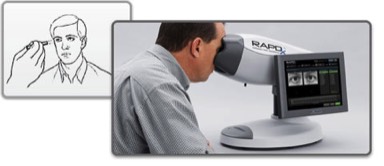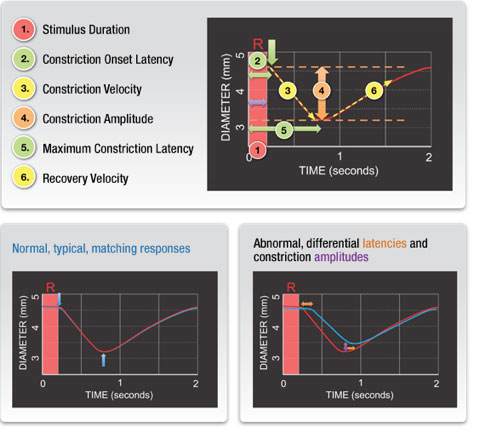WHAT IS RAPDx
The RAPDx device objectively, comfortably, and quickly assesses pupil responses in ways and in detail that human observers can't.
When a defect is present, the differential response between the two eyes may help your doctor discover the presence of important conditions. The historical method is subjective and requires a quite large defect in order to be detected.
When a defect is present, the differential response between the two eyes may help your doctor discover the presence of important conditions. The historical method is subjective and requires a quite large defect in order to be detected.

The RAPDx device objectively, comfortably, and quickly assesses pupil responses in ways and in detail that human observers can't. RAPDX quantifies the neuro-pupil response far more accurately than human observation allowing identification and quantification of defects not identified by standard testing.
When a defect is present, the differential response between the two eyes may help your doctor discover the presence of important conditions. The historical method is subjective and requires a quite large defect in order to be detected.
RAPDx is a pupillograph utilizing a high-definition, machine-vision system.
Historically, the best tool that your doctor had available was a flashlight to assess if your pupils worked normally. The problem with the manual method is that is difficult to do well and requires a fairly large defect to be seen.
The RAPDx device objectively, comfortably, and quickly assesses pupil responses in ways and in detail that human observers can't.
When a defect is present, the differential response between the two eyes may help your doctor discover the presence of important conditions. The historical method is subjective and requires a quite large defect in order to be detected.

The RAPDx device objectively, comfortably, and quickly assesses pupil responses in ways and in detail that human observers can't.
When a defect is present, the differential response between the two eyes may help your doctor discover the presence of important conditions. The historical method is subjective and requires a quite large defect in order to be detected.
WHY RAPDx

There is a substantial amount of published scientific research describing the importance of finding these defects to aid in the discovery of both eye and systemic diseases and conditions. If there were a device that could, in very high detail, objectively measure these defects as an automated, technician-administered test, this could substantially improve how these physical signs are collected. This is RAPDx
HOW DOES RAPDx WORK?
These are defects that human observers cannot see using historically available methods. RAPDx measures very small characteristic differences in pupil responses to novel stimuli. As your doctor we normally look for these differences manually but can only assess one eye at a time in a dimly lit environment, and they are often challenging to see. Viewing both eyes responses together to controlled stimuli in very high detail allows us as doctors to see new detail regarding "Relative Afferent Pupillary Defects" or "RAPD" and other important features that were not measurable before. These responses are recorded over short times to form a "RAPDx Signature™" as a biometric waveform, much like an EKG, but of pupil responses, recording differential responses (amplitudes, latencies, and velocities). Humans can't see this level of detail without a machine vision system.
RAPDx augments the doctor's vision with an automated device to find characteristic pupil response





